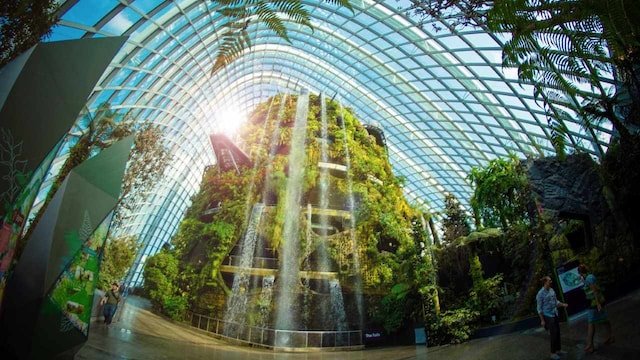Every item on this page was chosen by a Veranda editor. We may earn commission on some of the items you choose to buy.
Massacre Rim Wilderness Study Area, Nevada

This certified Dark Sky Sanctuary in remote northwestern Nevada is one of the darkest places in the U.S., with skies that reveal the Milky Way in staggering clarity. The wide-open volcanic plateaus and sagebrush plains create a frontier-like silence where stargazing feels truly raw. Spring through early fall is your best chance for warm nights and meteor showers like the Perseids. Bring binoculars—you’ll likely see more shooting stars than passing cars.
Where to Stay: Surprise Valley Hot Springs in Cedarville, California, about 45 minutes from Massacre Rim, offers private soaking tubs under the same starry canopy.
Jasper National Park, Alberta, Canada

Jasper is the world’s second-largest Dark Sky Preserve, where rugged peaks and reflective lakes frame dazzling celestial shows. Winter nights often bring shimmering auroras (but keep in mind this is Canada so it will be frigid), while July and August skies spotlight the Milky Way stretching across glacier valleys. The park also hosts an annual Dark Sky Festival in October with astronomy experts.
Where to Stay: Fairmont Jasper Park Lodge, set within the park, puts you less than 10 minutes from the best night-sky viewing points.
Advertisement – Continue Reading Below
Aoraki Mackenzie International Dark Sky Reserve, New Zealand

This alpine reserve blends glacial lakes, snowcapped peaks, and skies so dark they were the first in the Southern Hemisphere to earn gold-tier certification. Visitors can marvel at the Southern Cross, Magellanic Clouds, and, during the right conditions, shimmering airglow.
It’s also home to the University of Canterbury Mt. John Observatory, open for public stargazing nights. Visit during New Zealand’s winter months (June through August) for long nights, or spring and autumn for a balance of clear skies and mild weather.
Where to Stay: Mt Cook Lakeside Retreat, just 15 minutes from the observatory, features its own Pukaki Observatory.
Greater Big Bend International Dark Sky Reserve, Texas

Spanning over 15,000 square kilometers, this binational reserve across West Texas and northern Mexico is one of the darkest certified areas in the world. October through April, when skies are clearest and the nights comfortably cool, is the best time to see the Milky Way blazing in astonishing detail across the vast horizon. Rangers and local skyparks lead regular programs that showcase constellations and planets with laser-guided tours.
Where to Stay: Lajitas Golf Resort, nestled between Big Bend National Park and Big Bend Ranch State Park, is a 30-minute drive from prime viewing sites.
Advertisement – Continue Reading Below
Alqueva Dark Sky Reserve, Portugal

Spanning across the rural Alentejo region, this was the world’s first certified Starlight Tourism Destination. Olive groves, cork forests, and quiet villages provide a serene setting for Milky Way viewing, with sky interpretation programs offered by local guides. By day, it’s a landscape of vineyards and whitewashed towns; by night, galaxies are on full display. Visit from June through September for warm, dry nights and high Milky Way visibility.
Where to Stay: São Lourenço do Barrocal, about 20 minutes from a designated Dark Sky Alqueva observation site, offers a luxury countryside stay and stargazing experiences.
Acadia National Park, Maine

On Maine’s rugged coast, Acadia National Park offers some of the darkest skies in the northeastern United States. From Sand Beach or Jordan Pond, you can see the Milky Way stretch above granite peaks and the Atlantic Ocean, a rare sight in the eastern seaboard. Clear summer and early fall nights provide the best viewing, especially July through October, when the Milky Way is most visible above the rugged coastline.
Where to Stay: Bar Harbor Inn, just 10 minutes from Sand Beach, provides coastal luxury with easy access to nighttime skywatching spots.
Advertisement – Continue Reading Below
Mauna Kea, Hawaiʻi Island

At nearly 14,000 feet, Mauna Kea sits above most of Earth’s weather, making it a legendary spot for astronomical observatories and sunset-to-starlight tours. At the Maunakea Visitor Information Station, guests can stargaze with high-powered telescopes from mid-mountain while the world’s most advanced observatories scan from the summit.
The thin, clear air reveals southern constellations you can’t see elsewhere in the U.S. Check the community calendar for year-round stargazing events, but keep in mind that winter offers extra-clear skies and longer nights.
Where to Stay: Mauna Lani, Auberge Resorts Collection, located an hour from the Mauna Kea Visitor Center, combines beachside luxury with easy access to stargazing tours.
NamibRand Nature Reserve, Namibia

This private reserve in southern Namibia is one of only a few places designated a Gold Tier International Dark Sky Reserve, meaning that the region is exceptionally dark with near-pristine night skies. With zero light pollution and dry desert air, the Milky Way looks like spilled paint across the sky. Time your visit for May through September, during Namibia’s dry winter with crisp, clear nights. Many lodges even include astronomer-led sessions with high-powered telescopes.
Where to Stay: &Beyond Sossusvlei Desert Lodge, about 30 minutes inside the reserve, has its own observatory and star deck.
Advertisement – Continue Reading Below
Atacama Desert, Chile

The Atacama’s extreme dryness, high altitude, and near-zero rainfall make it one of the most celebrated stargazing destinations on earth. Night after night, constellations and galaxies shimmer in piercing clarity, and even the most casual skywatcher will easily spot the Magellanic Clouds and Southern Cross. Visit from March to October, when nights are cooler and atmospheric conditions are at their sharpest.
Where to Stay: Nayara Alto Atacama, located just outside San Pedro, is less than 15 minutes from community observatories and offers private stargazing programs.
Kerry International Dark-Sky Reserve, Ireland

On the Iveragh Peninsula along Wild Atlantic Way, mountains shield the coastline from light pollution, creating gold-tier darkness above the Atlantic. Visitors can join community-led star parties or simply gaze up after a cozy pub dinner. Winter months are especially good for Orion and the Milky Way, but September through March offers the clearest skies and crisp winter constellations. Also consider the moon phases, with the darkest skies occurring during a new moon.
Where to Stay: Sheen Falls Lodge in Kenmare, a 40-minute drive from the reserve’s core zone, blends Irish charm with luxury comforts.
Advertisement – Continue Reading Below
Tierra del Fuego National Park, Argentina

At South America’s southern tip, this remote park offers skies untouched by major cities and views of the southern constellations. The clarity here makes the Magellanic Clouds and Southern Cross pop against the horizon, while long austral nights extend stargazing time. Combined with glaciers, fjords, and Andean backdrops, the experience feels otherworldly. Visit from April to September, during long winter nights and when skies are at their clearest.
Where to Stay: Arakur Ushuaia Resort & Spa, perched on a natural reserve just 20 minutes from the park, provides sweeping sky views from its hillside perch.
Abisko & Jukkasjärvi, Swedish Lapland

Abisko’s unique microclimate results in some of Scandinavia’s most reliable aurora displays, with clear skies even when nearby areas cloud over. Winter brings near-nightly northern lights, while summer features brilliant midnight sun transitions. Late September to March is the best time to catch the northern lights, with peak activity in December and January. Pair it with a stay in the region’s most iconic property.
Where to Stay: The Icehotel in Jukkasjärvi, 15 minutes from Abisko National Park, provides themed suites and aurora excursions. And don’t worry, warm cozy rooms are available if you don’t want to sleep among the ice.
Watch Next

Advertisement – Continue Reading Below
Advertisement – Continue Reading Below
Advertisement – Continue Reading Below









